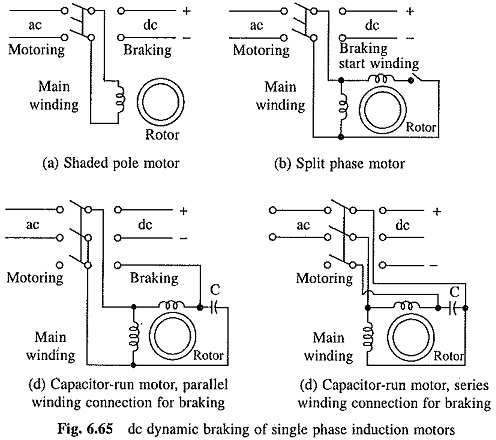Braking of Single Phase Induction Motor:
These motors can be braked by dc dynamic and plugging. The Braking of Single Phase Induction Motor are
DC Dynamic Braking:
It is commonly used for braking of single phase induction motors. With the help of a double pole double throw (dpdt) switch or tripple pole double throw (tpdt) switch, motor connection is shifted from ac (motoring) to dc source for braking. For various single-phase induction motors these connections are shown in Fig. 6.65.
In case of split-phase, capacitor run, and capacitor start and capacitor run motors, either main winding alone can be connected across the dc source (Fig. 6.65(b)) or main and auxiliary winding connected in series or parallel (Figs. 6.65(c) and (d)). When in braking connection, dc current through the stator winding (or windings) produces a stationary field through which squirrel cage rotor moves.
Currents induced in rotor bars interact with dc field to produce braking torque, as in three-phase induction motor. Motor decelerates and stops. As induced rotor currents are zero at zero speed, the braking torque is also zero. For braking, the supply is obtained by a diode rectifier connected to ac mains. Motor winding can be connected directly across diode rectifier to obtain fast braking. After the motor stops, winding is disconnected from dc supply.
Plugging and Reversal:
Except in case of shaded pole motor, plugging and speed reversal is obtained by changing phase sequence by reversing polarity of one of the windings.
Speed Control of Single Phase Induction Motors:
Speed of a single-phase induction motor is generally controlled by controlling its stator voltage which can be controlled by connecting a variable resistance in series with the stator. Because of poor efficiency the resistance control is now rarely used. Stator voltage can, also be controlled by the use of ac voltage controllers we know already. The speed of the motor can also be controlled by variable frequency control. However, it is rarely used because for most of the variable speed applications of single-phase motors, the stotor voltage control is good enough.
